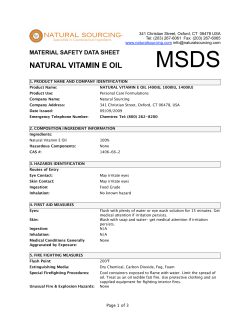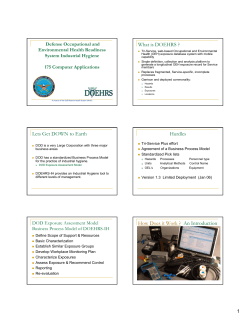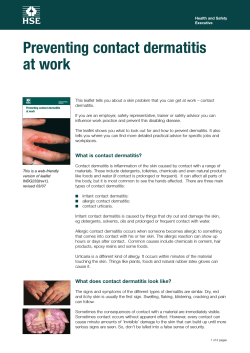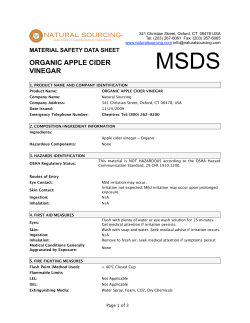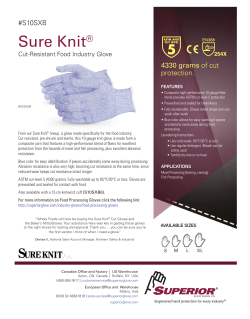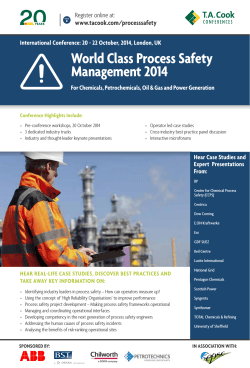
Document 204326
LAUSD FSD Construction Week of 21 January 2013 5 Occupational Dermatitis Hazards and How to Stop Them More than 13 million American workers face job-related exposures to chemicals that can be absorbed through the skin, in industries ranging from construction to health care and food service. The occupational skin diseases that arise from these exposures can be every bit as debilitating as occupational lung diseases or severe ergonomic injuries, forcing workers out of their jobs. Therefore, you should determine if the five risk factors for occupational dermatitis exist and must be addressed in your workplace. What Is Occupational Dermatitis? Dermatitis occurs when skin becomes inflamed and irritated. The two general types of dermatitis are primary irritation and sensitization. Primary irritation usually results from contact with a substance—such as strong acids, caustics, and solvents—in a significant quantity, concentration, and length of time. This affects the skin directly at the exposure site in different ways, depending on the type of chemical. For example, solvents work by removing fats and oils from the skin, while prolonged exposure to oils and waxes can plug up the skin's hair follicles and sweat ducts, causing inflammation and acne. Sensitization is an allergic reaction that occurs when the body’s immune system reacts to a substance. Workers may become sensitized after a single exposure to a substance, or they may be exposed to a substance for years before their body begins to react. Identifying Dermatitis Risks No industry can claim immunity to problematic skin exposures. For example: • Workers in construction are exposed to Portland cement. • Healthcare workers are at risk from latex, chemical sterilants and disinfectants, and hazardous drugs. • Agricultural workers' skin is exposed to pesticides. • Many hairdressers are forced out of their trade because they develop skin reactions to the chemicals they use on their clients. Any worker exposed to hazardous chemicals in the workplace should be aware of the potential for skin damage, the dangers of occupational dermatitis, and preventive measures, including wearing appropriate gloves to prevent contact. These five factors increase the risk of occupational dermatitis: 1. Frequent or prolonged contact with chemicals. A chemical that might be harmless or mildly irritating during occasional use can become much more hazardous with frequent or prolonged contact. Examine the safety information for any chemical that is in contact with workers' skin frequently or for prolonged periods to ensure that it does not cause skin irritation, sensitization, or systemic effects. Prepared by: RCS 1/22/2013 Source: Safety Daily Advisor “We Build on Safety!” 1 LAUSD FSD Construction Week of 21 January 2013 Also, look for less obvious sources of chemical contact. For example, pesticide residues will linger on plants, and workers who handle these plants may have significant exposures through the skin even after the waiting period required following pesticide applications. Sources of skin exposure include: • • • • Direct contact with contaminated surfaces Aerosolized particles Immersion Splashes 2. Skin that is already damaged. Intact skin can protect against many exposures, but damaged skin may permit chemicals that would otherwise be blocked to enter the body. Employees who work with chemicals that pose a skin hazard should be aware of whether they need to take additional precautions when they have scratches or cuts on their skin. Under some circumstances—for example, workers with large open wounds that could come into contact with chemicals—they may need to be temporarily reassigned. Workers exposed to mechanical hazards, such as friction, pressure, abrasive materials, or sharp edges, can suffer skin damage on the job that will make chemical exposures much more dangerous. Make sure chemical exposure hazards are not compounded by trauma hazards in the workplace. 3. Poor hygiene. Workers with dermal exposures should wash frequently so chemicals do not remain on their skin for long periods of time. Skin hygiene in the presence of hazardous chemicals is somewhat different from skin hygiene at home. Workers should: • • • • Wash their hands before putting gloves on so they do not trap hazardous materials against their skin. Wash their gloves before removing them so they do not transfer hazardous chemicals from the gloves to their skin. Wash their hands after removing contaminated gloves, and dry their hands gently, but thoroughly. Use only moisturizers provided by the employer that will not damage gloves, and apply lotions and moisturizers only to clean skin. Note: If pH is an issue (as it is for workers who use Portland cement), employers should provide pH neutral or buffered soaps at work, and workers should also use them at home. 4. Temperature extremes or exposure to sunlight. Heat and cold both stress the skin, making it more susceptible to chemical injury. Sunlight, too, can make some exposures more dangerous through its interaction with chemicals. 5. Wet work. A chemical that might not ordinarily penetrate the skin in large amounts could do so under wet conditions—including heavy perspiration—because wet skin is more permeable than dry skin. Workers in wet environments may need to take precautions—such as wearing gloves—that would not be necessary if their skin were dry. Tip: Workers who use solvents, such as methylene chloride, may be tempted to clean their skin with it. Teach them about the hazards and to clean their skin with soap and water only, rather than with potentially hazardous solvents. Prepared by: RCS 1/22/2013 “We Build on Safety!” 2 Source: Safety Daily Advisor LAUSD FSD Construction Week of 21 January 2013 Topic 5 Occupational Dermatitis Hazards and How to Stop Them TRAINING SIGN IN SHEET Dat e: ____ Time: ____ School/Office:_____________________________ No. of Associates Trained: ____ No. Minutes of Training: ___ Presenter: (print & sign) _________________________________________________________ Other Topics Discussed: _________________________________________________________ 1. 19. 2. 20. 3. 21. 4. 22. 5. 23. 6. 24. 7. 25. 8. 26. 9. 27. 10. 28. 11. 29. 12. 30. 13. 31. 14. 32. 15. 33. 16. 34. 17. 35. 18. 36. Continue on backside if additional associates Prepared by: RCS 1/22/2013 Source: Safety Daily Advisor “We Build on Safety!” 3
© Copyright 2025




